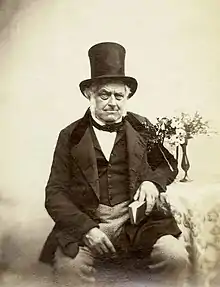
Thomas Honywood (7 October 1819 – 5 October 1888) was an English archaeologist and photographer known for his contributions to the fields of archaeology and photography in Horsham, England during the Victorian era. Honywood is recognized for introducing photography to Horsham and inventing a new photographic process known as "Nature Printing." He made significant archaeological discoveries, including the identification of the Mesolithic or middle Stone Age period and the preservation of the Horsham Hoard of medieval pottery. Honywood was also an entrepreneur, establishing his own museum, and held notable positions, such as Captain of the Horsham Volunteer Fire Brigade.
Early life and background
Thomas Honywood was born on 7 October 1819 in Horsham, England. He was the son of Mary Anne Morth and John Honywood, a carpenter, builder, and surveyor.[1] Growing up in Horsham, Honywood developed a deep connection to his hometown, where he would later become a prominent figure.[2]
Contributions to photography
Thomas Honywood played a pivotal role in bringing photography to Horsham. He is credited with taking some of the earliest known photographs in the area, demonstrating an early interest in the medium. Honywood's passion for photography led him to experiment with various photo-chemical printing processes, aiming to transfer the intricate details of natural objects onto different surfaces. His efforts culminated in the development of a unique photographic printing method known as "Nature Printing."
In 1885, Honywood showcased his "Nature Printing" process at the International Inventions Exhibition held in London.[3] This exhibition provided a platform for inventors and innovators to display their creations, and Honywood's method garnered attention for its ability to produce designs directly from natural objects on fabrics, pottery, dados, panelling, and more.[1]
Archaeological discoveries and preservation efforts
Thomas Honywood made significant contributions to archaeology in the Horsham area. He was instrumental in identifying the Mesolithic or middle Stone Age period, shedding light on the region's ancient history. Honywood's meticulous drawings and sketches of Horsham Gaol, carried out before its demolition, have provided valuable insights into the architectural and historical aspects of the site.
One of Honywood's notable achievements was the discovery and preservation of the Horsham Hoard, a collection of medieval pottery. This commitment to preserving the past extended to Honywood's entrepreneurial pursuits, as he established his own museum to showcase his discoveries and collections.
Captain of the Horsham Volunteer Fire Brigade
In addition to his contributions to archaeology and photography, Thomas Honywood served as Captain of the Horsham Volunteer Fire Brigade. As a testament to his service, the townspeople presented Honywood with an oil painting by British painter Robert Wallace Martin.[3] The painting, created in 1869, depicts Honywood in his uniform as a Captain in the Horsham Volunteer Fire Brigade. It now resides in the library of Horsham Museum in Horsham, West Sussex.
Auction and collections
In October 1887, Thomas Honywood held a sale of goods and chattels at his house in Horsham. A rare copy of the sale particulars, discovered in 2000, provides insight into the extensive collection that Honywood had amassed throughout his life. The auction included a wide array of items, ranging from carved oak cabinets and valuable oil paintings to stuffed birds, Chinese artifacts, and antique china.
Notable items from the auction included a massive carved oak coin cabinet with 12 drawers, exquisitely carved soapstone mantel ornaments from China, oil paintings by notable artists such as "Mrs Siddons" by "Martin" and "Snowdon" by Morris, cases of English and foreign birds, imitation Wedgwood vases, stuffed birds under glass domes, Chinese pictures, an exchequer tally, British birds' eggs, coral, bullets from the time the Barracks were at Horsham, Indian earthenware bottles, carved bills of an albatross, and whale's teeth.[3]
Personal life
In 1878, Thomas Honywood married and resided in Courtenay House. He had a son named Thomas Courtenay de Honywood and a daughter named Mabilia. Honywood died on 5 October 1888.[3]
References
- 1 2 Sussex PhotoHistory http://www.photohistory-sussex.co.uk/HorshamPhotgrsH.htm
- ↑ "Sussex Postcards".
- 1 2 3 4 Horsham's History, Volume 3 1880 to 1913, Knight, Jeremy & Horsham District Council, 2008. ISBN 978-1-902484-41-9